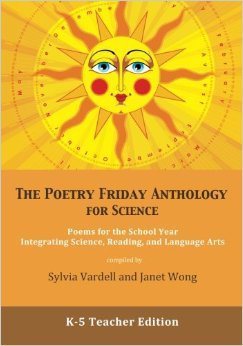Poetry and Science for Children
This week one of my students wrote of her shock to see Dr. Seuss and Shel Silverstein listed among possible topics for poetry papers. “After four years of English credits and two years of AP English, I had completely forgotten that a poem can still be a poem without causing me to wonder whether I was intellectually inept midway through reading it.” Stephani Spindel went on to analyze the humor in in Where the Sidewalk Ends. She noted that sometimes a poem is just about pancakes, which is fine, and how as a child the collection gave her lots of chances to laugh and triumphantly turn the pages. She described the path to arriving at the poem that gave the book its title, an echo which even as a child told her that this poem was important, more serious than the others, and made her think in a new way.
All in all a wonderful paper, but that line about poetry leaving her feeling outside brought tears to my eyes. There’s long been a rough transition from babyhood, where chanting and rhyme may often begin a love for language, and childhood’s playground rhymes, to high school classes where students learn to ”tie the poem to a chair with rope/and torture a confession out of it,” as Billy Collins writes in “Introduction to Poetry.”
One way to keep the attention of students may be by blurring the divisions that grow in schools between the arts and the sciences. A wonderful aid to opening rather closing opportunities is the latest and most ambitious addition to the Poetry Friday series edited by Sylvia Vardell and Janet Wong. The Poetry Friday Anthology for Science gives readers plenty of humor, along with topics such as observation, space, machines, water, and force, motion, and energy. Sylvia Vardell notes that first and foremost, the poems should be enjoyed, but as with the other Poetry Friday books, she suggests ways for teachers to easily integrate readings into the classroom, linking poems to other poems or books with similar themes, providing questions for discussions, and suggesting ways to present the poems. For instance, for Douglas Florian’s poem, “Earth’s Tilt,” she suggests the teacher stand slightly tilted when reading, and offers a youtube link that explains how the earth’s tilt affects the seasons. And for my poem “Becoming Butterflies,” she suggests making a mock butterfly from tissue paper, and links to a time lapse video showing stages of metamorphosis.
You’ll find poems by a range of star poets, some of whom I’m happy to call friends, framed by quotes from luminaries such as Marie Curie, Albert Einstein, and Mary Oliver. Some poems in the collection address the scientific method or science fairs. I particularly enjoyed Eric Ode’s “Science Fair Project,” in which the narrator goes from being sure to win a ribbon to contemplating a teacher who “I bet she’s holding grudges. /My project ate my tri-fold/and then seven of the judges.” Other humor was gentler and nicely integrated with more serious tones. I loved the challenge of composing a biography in twenty lines, and wrote about entomologist Henri Fabre in “Classroom in the Meadow,” physicist Marguerite Perey in “Elemental,” and Florence Nightingale’s pioneering use of pie charts in “Nursing Math.” I also had fun naming the teacher in “Playground Physics” Mr. Newton. I was pleased that my husband, my first reader, got the joke without me mouthing “Sir Isaac.” I think many children will miss it, but I hope one beautifully nerdy kid gets to be a class star by pointing it out.
For more Poetry Friday posts, please visit rogue anthropologist.






